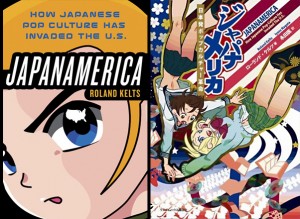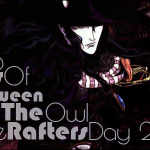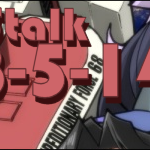How Roland Kelts Invaded Otakon 2011 – The Owl in the Rafters

I feel bad that this has taken me so long to get to, but more than a month ago now I attended Otakon 2011 in Baltimore, Maryland. As one of the premier anime conventions in North America and the largest on the East Coat, Otakon is often proud to boast a large selection of panels, industry guests, and musicians from both Japan and America. Among the guests these year however was a guest with his hand in a little bit of everything: Japanese-American fiction writer, journalist, musician, college professor and lecturer both in America and Japan, and of course anime fan, Roland Nozomu Kelts.
As the author of the 2006 publication, Japanamerica: How Japanese Culture has Invaded the U.S., Roland Kelts appeared at Otakon this year not only to sign autograph and book signing sessions but also as the host of 4 different panels (Japanamerica and Japan’s Apocalyptic Imagination in Anime, Manga, and Art on Friday, Pop Culture From a Multipolar Japan on Saturday, and Japan’s IP Problem on Sunday) over the course of the weekend covering various aspects of his book, Japanamerica, and the research that went into it.
During opening ceremonies, Kelts was introduced as an “academic guest” –though Kelts himself complained it made him sound a little boring– and as such did a marvelous job in his panels touching upon some of the major academic approaches central to analyzing anime and the subculture surrounding it: art history, art theory, film study, anthropology, cultural studies, and business.
In Japanamerica, Roland Kelts tackles his broad subject in 9 different chapters, each with a different approach to looking at the anime/manga subculture in both America and Japan, and of course how the two interrelate. The first of these addresses the history of American localization and just what it was about early anime shows like Battle of the Planets that made them so appealing to American audiences. The differences in Japanese and American societies at the time called for a different kind of psychological fulfillment. In simpler terms; in an industry of children’s entertainment over-saturated with like-minded productions, anime presented American children with fresh new, different, and meaningful ideas.
*That is the English cover on the left of the above image, and the Japanese cover on the right with cover art by who I am assuming is NisiOisin (original creator of Katanagatari, Bakemonogatari, and Kizumonogatari) although I can’t confirm that and it could just as easily have been by one of the Katanagatari anime art staff mimicking his art style.
After tracing the appeal points of anime to Americans, Kelts takes the next logical step back in chapter two and examines just what it was about Japanese culture that produced such edgy mediathat was so drastically different from its American counterparts at the time. He points chiefly to Japan’s long history of cultural trauma, both from the multitude of natural disasters centered around Japan’s geographical location and of course Japan’s military history and relationship with America, from Admiral Perry, to WWII, to the Vietnam War. He points to the World Trade Center attacks of 2001 as America’s first real experience with social trauma that directly threatens the public and not just the government.
He draws parallels to the firebombings in Japan during WWII, in which American war tactics favored indiscriminate bombing of all buildings, not just military installations, where the Japanese civilians were not so fearful of losing the war as they were fearful for their lives. This kind of vulnerability affects a population and calls for a certain kind of shift in popular trends towards national empowerment. In the case of Japan’s casualties in WWII as well as the usual natural disasters it calls for subtle themes of technological power and man-vs-nature. He also suggests that the relative comfort and lack of trauma in modern Japanese creators(prior to the earthquake and nuclear plant meltdown) as a possible cause for the recent change in themes over the years.
A later chapter also addresses the appeal to branch groups within the anime subculture like collectors and cosplayers. The real hook of anime and manga could really be argued to be less in product itself and more in the fandom, which is not always a comforting thought, personally. Not to undermine this section in particular, but my own interest falls outside of the category so I’ll just set it aside, out of harm’s way, and move on.
Another chapter addresses Japan’s interrelated approach to producing and marketing toys and other collectable products like card games along side hit anime titles. The need to make a vast multitude of toys in Japan is tied to Japanese business practice, which is somewhat infamous world wide for being strictly number driven and at one point almost ruthlessly efficient. What this means is that Japanese businesses put a great deal of value on quality and productivity above all else and the emphasis on physical product is in part meant to counteract the instability of the anime market.
Perhaps you’ve never thought of it in regards to business, so I’d like to try my hand at putting a little bit of this into perspective: Think of every infomercial or every dollar store, super market, Target, or Wal-mart you’ve been to I’m sure you can recall all sorts of silly products that you laughed at, thinking, “What idiot thought this up?” Well consider for a moment that those idiots don’t just happen to own factories ready made to mass produce their terrible ideas. No, every one of those idiots has a backer of some sort who throws money at the necessary people to get their stupid product off the ground. Why are people so willing to pour money into these kinds of seemingly stupid projects? Because they’re banking on the venture to pay off, of course.
This idea of investment and projected returns is simple enough, but this is a point over which American and Japanese business can sometimes differ. In general, Americans tend to be remarkably open to the idea of throwing all their money down on preposterous gambles on uncertain products or ideas, especially when compared to the rest of the world; the Japanese however are just the opposite. Japanese businesses much prefer to produce only when they have some measurable sense of how well a product will do, and for stylistic and highly subjective ideas with no physical numbers -things like anime- making that leap of faith needed to throw down the money to make a product is difficult. One clear sign of this mentality is that once upon a time an anime would be contracted for a year long run at a time with between 49-52 episodes. In the 2000s that suddenly got cut in half to 2 season/6 month contracts with 24-26 episodes. And if you keep up with anime at all now’days you’ll realize that an average show will run just a meager single season of as little as 11-13 episodes.
In what some call a dying industry, the long term commitment to a project that may flop in three months, or even succeed but go stale after six months, the Japanese simply aren’t willing to trust their investments to any one series. As a result a sort of brand loyalty to trends has also become almost crippling in that many of the manga being adapted into anime are all similar in plot, story, and character types.
How can an industry be dying if they still produce so many new anime? you may ask. Well, in two other chapters Kelts goes on to explain how the entertainment businesses responsible for hit games like Pacman, as well as big name animation studios, are all remarkably small outfits with incomes significantly smaller than what many fans seem to imagine. A good deal of this is traced back to the early rise of anime in Japan, which Kelts addresses. The godfather of anime, Osamu Tezuka, while a great pioneer of animation in Japan is also one of the chief causes of the industry’s shortcomings, including the unreasonably low wages of animators in Japan.
Kelts also goes over Japan and the anime industry’s desperate struggle to get up to date with intellectual property(IP) laws. As it stands, Japanese artists have very little control over their intellectual property and yet the companies that do have little to no sense of how to effectively regulate or distribute said IP in the ever expanding and quickening sea of digital media. This idea of what Intellectual Property is and how it can/should be handled professionally, as well as Japan’s struggle with learning to adapt to American business practice concerning it, was the subject of one of Kelts’s Otakon 2011 panels: Japan’s IP Problem.
This concept of addressing intellectual property via the legal system is all fairly new even in America. Western comic book fans and generally current event aware geeks may be familiar with the dispute over the ownership of the Captain America character, spotlighted in lieu of the recent film. The Japanese generally don’t have these kinds of debates, as their legal system is not as prone to nitpicking the minor implications and specificities of legal contracts. As far as the Japanese tend to be concerned, when they sign a contract with a company the contract acts exactly as stated, with no room for abstract interpretations or semantics. America of course has made an entire business of finding and abusing any and all holes in legal documents in order to wiggle in and out freely of nearly any dispute. It is because of this lack of finesse in business law that many Japanese companies do not have adequate means to protect their own IP.
At this point I could probably go over most of the points I found interesting in the book in detail, but I feel that defeats the purpose. So then, I’ll move away from the heavier subjects and just wrap things up with my feelings about the book.
What I love most about books like this in general, but specifically with Kelts’s personal approach, is that it puts the remarkably narrow vision of American anime fans into a comprehensive academic context. Too often American fans leave the real history, business, and cultural context of how the anime business and culture works in its native setting up to their imaginations. To be fair of course, they often have little to no way to really put things into context themselves, short of traveling to Japan and spending a few years to adjust, absorb, and then really examine the culture there. American anime fans are often even below the level of a normal hobbyist if only because, for all the time they dedicate to anime and manga, they have no real understanding of the artistic, literary, or business aspects of anime. This is part of what propagates bogus propaganda like “buy the official English release of your favorite series and help support the original creators!”
It really should go without saying but businesses DO NOT work via some kind of convoluted piecemeal system where every dollar you spend gets split up between the store you bought it from, the store’s franchise owner, the publisher/distributor, the translators/writers/localization team/dubbers, the Japanese mother company, the Japanese animation team, and then somehow at the end of the day the original artist/author. I hate to sound like the cynic (Oh who am I kidding? I love it.) but buying the English dubs, DVDs, and manga does nothing to support the industry abroad.
I could really go on and on about this but anything I say you could just as easily read about in Japanamerica: How Japanese Pop-Culture Has Invaded the U.S.. So, moving away from what may be a depressing or confusing subject for some, I’d like to point out that Japanamerica also covers many of the facets of Anime’s appeal in America in a clear comprehensive way -without being bogged down with arbitrary geek terminology- that makes it a decent starting place for people not acquainted with anime at all, as well as a real eye-opening experience for fans.
The book itself is not very long (less than 300 pages) and despite taking an academic approach to studying anime the writing style is not oppressively heavy and each chapter is broken into various smaller segments, so the book is remarkably convenient for picking up and putting down on the fly on top of being easy to read and process.
Japanamerica: How Japanese Pop Culture Has Invaded the U.S. is available in both hardback and paperback both online and in most major book retailers at prices starting as low as 10.00 USD new -even less used if you dig around a bit for good bargains online- and really, at those prices, there’s no reason not to pick up a copy and read through it.
I would have ended the article right there, but I’m just going to say it to get this off my chest: My favorite part of Otakon weekend was easily Roland Kelts’s Japan’s IP Problem panel on Sunday afternoon. I took a certain almost sadistic pleasure in hearing the horrified gasps of a room full of mortified anime geeks when Kelts began pointing out that not only do Japanese animators and comic artists/authors make a truly pathetic pittance for their work (especially when compared with American counterparts) but the American market shares none of its profits with the original Japanese companies, let alone any of the actual creators. In fact, more often than not, American licensing deals will shortchange their Japanese business partners, paying only a tiny fraction of the eventual profits in a flat rate payment up front after which point the Japanese see none of the American sales profit.
I know not many of you are probably not terribly savvy when it comes to basic business, so try and think of it this way: Imagine for example you sell a friend an old saucepan that you figure you’ve gotten your use out of for $10; then imagine that your friend uses that saucepan to cook spaghetti that he/she sells to other people for $5 a plate. In a few short days your friend is now sitting on $100 and still making a profit (now more than 10x what you got out of the deal) that came from your saucepan and he isn’t about to share. The sale was legit and by all means fair -what he does with it is his business now, he paid for it- and he’s not obligated to share, but you certainly can’t help but feel like you’ve been cheated.
before I let you go, I want to make clear that I really don’t intend to paint American anime companies as some kind of swindlers or villains here. Buying English releases will of course help support the companies that need your money to pay for bringing more of what you love from Japan to you here in the states, and it really is money well spent that supports to community you love. Just remember that the people you’re helping are the American companies, and that your money in no direct way affects the profits of the Japanese. No one wants to hear or see misguided and misinformed crusaders fighting piracy in all the wrong ways and for all the wrong reasons. The More You Know!
Anyhow, enough of my rambling. Once again Japanamerica: How Japanese Culture has Invaded the U.S. is available in both hardback and paperback, both online and in most major book retailers, at prices starting as low as 10.00 USD. So, go check it out!


















When did his panel get moved to? I was going to go to it after the Kaiju panel, and then he did a no show, and stayed for the Satoshi Kon panel.
Actually if I recall he didn’t show up to his very first panel in the end. We were in the same room together the whole time though! I also sat through waiting for Kelts’ first panel on Friday and stayed for the Satoshi Kon memorial.
That is hillarious, but it is a huge convention.
Sayin’ Otakon is a big convention is like saying One Piece is a long anime series 😛 Bargain Gamer told me about the book and it seemed pretty cool.
Indeed, it is a pretty cool book! A perfect springboard for the casual anime fan looking to take the magnifying glass to the real details of the history, culture, and industry of anime.